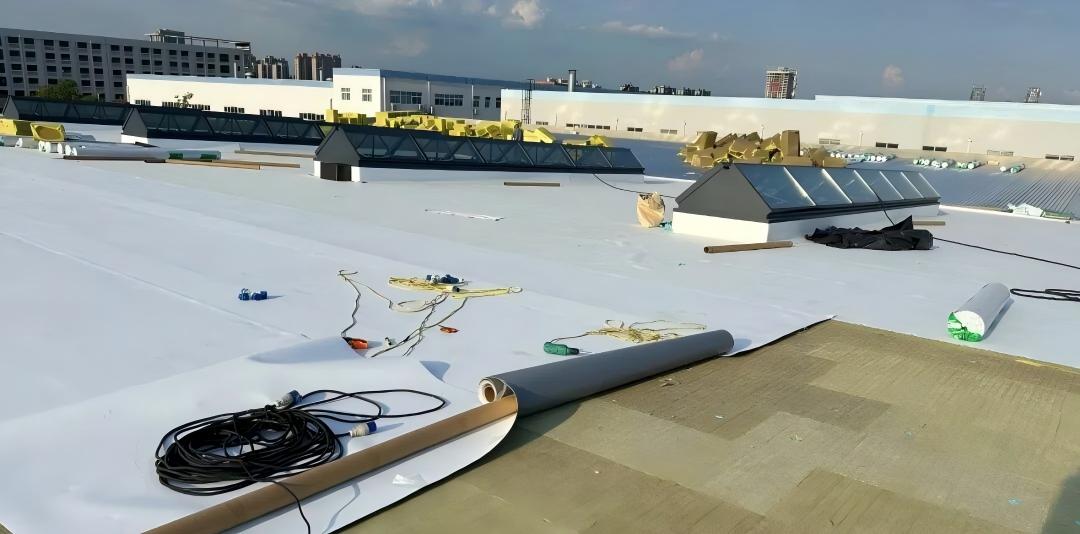Faced with the challenges of continuously increasing energy consumption and carbon emissions in the construction sector,finding efficient and versatile material solutions is crucial,especially in key areas of the building envelope.In roof systems,a major source of building energy loss,TPO (thermoplastic polyolefin) membranes are becoming a new favorite in modern building waterproofing and energy conservation due to their superior performance and comprehensive advantages.
1.Energy consumption and waterproofing challenges of building roofs
Building roofs are directly exposed to the external environment,subject to constant exposure to the elements like sun, rain,and temperature fluctuations.They are not only a critical component for waterproofing and leak prevention,but also a weak link in a building's thermal performance.While widely used, traditional asphalt waterproofing materials suffer from poor weather resistance,aging, and significant construction pollution.Furthermore,their dark surface absorbs heat, exacerbating the building's cooling load.Statistics show that building roofs can contribute over 30% of the overall cooling load,particularly in hot summer regions,where cooling energy consumption rises significantly.
2.TPO membrane: a comprehensive solution with excellent performance

TPO membrane is a synthetic polymer waterproofing membrane made from thermoplastic polyolefin (TPO) with added functional additives such as UV inhibitors,antioxidants,and flame retardants,manufactured through an extrusion process. Its key advantages include:
1. Excellent weather resistance and durability:TPO material offers strong UV resistance and is resistant to aging and cracking even after long-term outdoor exposure.Its service life can reach over 30 years,far exceeding that of traditional materials.
2. High reflectivity and energy efficiency:White or light-colored TPO membrane boasts a solar reflectivity (SR) of over 80% and a hemispherical emissivity (HE) of over 70%,significantly reducing solar radiation absorption,lowering roof temperatures and reducing air conditioning and cooling energy consumption. Research shows that buildings using high-reflectivity TPO roofing can reduce summer air conditioning energy consumption by 10%-20%.
3. Excellent mechanical strength and workability:TPO membrane exhibits strong tear and puncture resistance,making it suitable for a variety of roof structures.Its hot-air welding process ensures strong seams,creating a seamless,reliable waterproof layer.
4. Environmental protection and recyclability:TPO material does not contain chlorine (unlike PVC),is environmentally friendly and recyclable,and meets the requirements of green building and circular economy.
3.Application Examples of TPO Membrane

(1) Commercial Building Flat Roof Systems
TPO single-ply roofing systems are widely used in large commercial buildings, warehouses,logistics centers,and factory buildings.They not only provide reliable waterproofing,but also effectively reduce the heat island effect through their highly reflective surface,thereby lowering building energy consumption.For example,after Tianda Waterproofing partnered with an e-commerce warehouse center,the use of 1.5mm thick white TPO membrane reduced the roof surface temperature by up to 15°C compared to traditional black asphalt roofing,and reduced summer cooling power consumption by approximately 18%.
(2) Energy-Saving Retrofit Projects
In the energy-saving renovation of existing buildings,TPO membranes are often used in combination with insulation layers to form an integrated"insulation-waterproofing-energy saving"system.
(3) Green Building Certification Booster
Due to its high reflectivity and environmentally friendly properties,TPO membranes are considered a plus in certifications such as LEED, BREEAM,and the China Green Building Label,helping projects achieve green building goals.
4. Application prospects of TPO membrane

(1) Huge Market Growth Potential
With increasing global demand for building energy efficiency,urban heat island effect control,and green building,the high-reflectivity roofing market is experiencing rapid growth.It is expected that by 2030,TPO membrane will further increase its share of the global roofing waterproofing market,particularly in Asia Pacific and North America.
(2) Technological Iteration and Cost Optimization
Although TPO membrane currently costs more than traditional asphalt-based materials,its cost is gradually decreasing with the scale-up of raw material production,process optimization,and development of recycling technologies.Furthermore, the new generation of TPO products continues to innovate in areas such as anti-fouling,self-cleaning,and color diversity, expanding its application scenarios.
(3) Policy Support and Standard Improvement
Many governments have included high-reflectivity roofing in building energy efficiency regulations,such as China's Green Building Rating Standards and the US's ENERGY STAR® Roofing Program, providing policy support for the promotion of TPO membranes.
5. Challenges faced by TPO membranes

(1) High Initial Cost
TPO membranes have high requirements for raw materials and construction,resulting in higher initial investment than traditional materials,which may affect their selection for some budget-sensitive projects.
(2) High Construction Process Requirements
TPO membranes require specialized welding equipment and technicians.Improper construction can lead to joint failure,compromising the overall waterproofing effect.
(3) Market Competition and Material Differentiation
Compared to polymer membranes like PVC and EPDM,TPO membranes need to further highlight their comprehensive advantages in environmental protection,weather resistance,and energy conservation,and strengthen market education.
6. TPO membrane, the future choice for building green roofs

In summary,TPO membranes have become a key choice for modern building roofing systems thanks to their excellent waterproofing performance,significant energy savings,environmental adaptability,and sustainability.While challenges remain in terms of cost,construction,and professional awareness,with technological advancements,policy support,and growing market acceptance,TPO membranes are expected to play an even more significant role in building waterproofing and energy conservation,contributing crucially to global building emissions reduction and sustainable development goals.